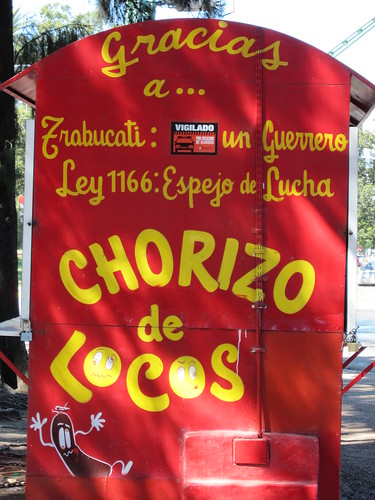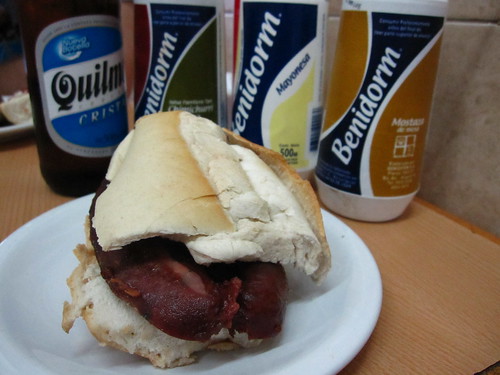Virtually everywhere they make sausages, and in a lot of places they don’t, some form of sausage in bread combination is sold by street vendors, often to the inebriated, and, in many cases, the consumer is best advised to be under the influence before taking their life in their hands with one of these mystery bag sandwiches. The night I met my wife, for example, I remember being horrified that her sister (who had introduced us earlier in the evening) was reckless enough — even after 50 drinks — to buy an insanitary-looking sausage in a roll from a street vendor in London’s Piccadilly Circus.
Where sanitation isn’t the biggest issue, a sense of disappointment often is, with the boring and insipid offerings available at any of the myriad hot dog stands lining almost every Manhattan street exemplifying this. Do not get me wrong, a New York hot dog — pulled from the disquietingly opaque water, slapped into a curiously spongy potato roll, and painted with mustard and an unidentifiable relish – is certainly a real taste of NYC street life, and when you’ve been pounding the city streets for an afternoon, almost enjoyable, but it is not great street food, regardless of what Adam Platt at NYMag says. (feel free to post your own disagreements with me below)
However, the more I travel, the more I realize that these sausage and bread combos can actually be both safe for human consumption and, in some cases, a delicacy. You may remember our merguez frites sandwich of last year, which was not just the best street food we’d ever had, but right up there with the finest sandwiches too. Even the overtly filthy nature of that vendor in Carcassonne failed to put us off. Indeed, it’s probably true that we would risk a searing bout of intestinal drainage on a weekly basis if only merguez frites were readily available.
So, during our recent trip to Argentina we were intrigued by rusty little cabins that we passed throughout Buenos Aires, either parked-up or slumping shack-ily on the sidewalk, emitting wonderfully aromatic smoke and advertizing choripán and morcipán on gaily painted signs. After one particularly lengthy trek across the city from Palermo to Recoleta to the edge of Balvanera, we were ravenous and mentally-prepared for something of questionable hygiene wrapped in a roll and doused with condiments.
Following a tip we had picked up online, we headed to the corner of Avenida Juan B. Justo and Avenida Santa Fe in Palermo [right next to the Palermo Subte stop (D line)], to a very sweaty looking snack bar for a pre-dinner choripán — a chori(zo) on bread (pan). Smaller than our pitifully-sized Brooklyn apartment and decorated with aging posters of scantily-clad beer models, our senses immediately told us that this cafe was exactly the kind of place that would deliver the equal measures of delicious, greasy victuals and stinging doses of the raging squitters we were looking for. [Happily, only the former arrived.]
Your typical sausage and roll combination features a roll that follows the dimensions of the sausage: long and narrow. However, one of the many things I immediately liked about choripáns and morcipáns is that they invert this absolutist relationship on its head. The sausage is split down the center, seared on both “faces” a la plancha and, dripping with bright orange fat, is placed inside a rectangular hunk of French-style bread. Not only is it texturally superior to its flimsy American counterpart, but its increased surface area and the greater density of the bread, make it a far better designed sandwich than the hot dog. As, enclosed in a larger roll, your choice of condiments — in this case, mayonnaise, “golf sauce” (not unlike Russian/Thousand Island dressing), ketchup, mustard, and chimichurri — are less able to escape and damage shirt or shoes, as frequently happens when biting down on the open-topped frankfurter.
Unfortunately, once you go choripán, you can never go back, and their absence from my everyday street food scene has become a source of extreme frustration now that I’m back in New York. Passing-by vendors of the humble hot dog several times a day, I can’t help sneer a little at their meagre offerings of limp weiner and rubbery potato roll, and I mutter to myself that the magnificent, spicy, chewy choripán is a shining light compared to their ghostly reflections.
Happily, choripáns and morcipáns are easy and fun to make in the comfort of your own home and make a great alternative to the unimaginative backyard barbecue staples of weiners and burgers. Perhaps unsurprisingly, we couldn’t find Argentine-style chorizo in Brooklyn, but the easy to find, and similarly fresh and soft Colombian and Mexican varieties make worthy replacements, even if they are longer and slimmer than their Argentina counterparts. This past weekend, humming “the choripán man, the choripán man’s really got it going on…” inanely to ourselves, we mixed-up a tangy chimichurri, grilled ourselves some chorizo, and enjoyed a taste of Buenos Aires with a cold beer, even if we had to imagine the warm weather and palm trees.
Note: there are about as many recipes for chimichurri as bits of charred animal to serve with it, so feel free to tinker with this one as much as you like. Please also note that, contrary to popular opinion, chimichurri is rarely served with steak. Salsa criolla seems to be the steak sauce of choice in Argentina and Uruguay. Chimichurri is reserved for sausages and organ meats.
Ingredients:
- 1/4 onion, finely diced
- 1-2 cloves garlic, smashed and finely diced
- 4 tsp flat-leaf parsley, finely chopped
- 2 tsp dried thyme or 3tsp fresh thyme, finely chopped
- 1 tsp dried oregano, or 2tsp fresh oregano, finely chopped
- 1 tsp red pepper flakes
- 1/2 cup (ish) good olive oil
- 2tbsp white wine vinegar
- (optional) juice of half lemon
- (optional) 1/2 tsp lemon zest, finely chopped
- salt
- black pepper
Recipe
- Combine all ingredients in a non-reactive bowl
- Stir well and allow to improve overnight or for at least an hour
- Taste before serving and correct seasoning and acidity.
- Serve with your choripán, morcipán or tablita parillada (mixed grill)






Tempting tempting …
I love chimichurri so much!!!!!!!!
Definitely doing this. Oh, yeah.
C is scared of anything spicy, but D loves this kind of stuff and so do I. We’re also blessed with a local organic butcher who does a mean fresh chorizo.
Honestly…we will eat almost anything from a street vendor. Is that kosher? Probably not. But the food is always so good! This choripan would surely be gobbled right on up with chimichurri galore.
My husband and I were talking about how “corporate” street eating is in America–there are exceptions but they are not the norm. Where as street eating in other places is so satifying to the senses (smell, taste, sound).
…and I was satisfied with my Costco dogs….
Thanks for the tip re chimichurri. On sausages, you say. . .as if we needed another reason to drink the stuff.
Questionable hygiene is where it’s at. Living in the “First World” for some time now, I’ve retreated and lost a bit of my courage. Time to rediscover the world. . .;)
Jen – you’d be surprised that again, contrary to popular opinion, chimichurri is not spicy, per se. Argentines seem pretty spice averse, at least in a chile sense, and while most chimichurris contain some red pepper, the resulting sauce is usually pretty mild and herbacious.
MM/JS – i couldn’t agree more. In my mind, in a street food taste test the sweatier and grimier the vendor, the more likely their food is to win. Not to mention that, outside of America most street foods don’t come pre-packaged or pre-cooked and require some kind of cooking or longer preparation by the vendor, not just immediate assembly, which is another winning trait in my book.
“I can’t help sneer a little at their meagre offerings of limp weiner and rubbery potato roll.”
Haha, I just imagine you sneering left and right on the streets of New York.
The bottles of condiments remind me of craft paint or glue. Dunno why!
I’ll try to make this sometime, since I haven’t tinkered with my sausage-making attachment since the salmon loukanikos last fall.
Heather – fair point. many of little choripan shacks we passed had bowls/jars of freshly-made condiments instead of the factory-produced glue-lookalikeys here, but for me the most amusing thing about them is their brand name: Benidorm. In UK, Benidorm is widely derided as perhaps the worst of the resorts on Spain’s costa blanca, because of its reputation for cravenly catering to the worst kind of British tourist, i.e. ultra-cheap booze in British-style pubs, fry-ups for breakfast, cups of tea, horrific nightclubs and fish n’chips widely available. That these dodgy-looking bottled condiments would be called Benidorm, especially given their sweaty snack-bar context, is therefore all the more fitting.
It’s only sausage when having street meat or entertaining. If I were served hot dogs at a party…I would seriously question the friendship.
Hola! I’m argentinian and, of course, I love choripán. Actually, it’s one of the main reasons why I didn’t become a complete vegetarian yet.
I just wanted to tell you that (despite the fact that there aren’t really many palm trees in Buenos Aires) the description you made of your discovery of the choripán was absolutely great! (Glad you liked it!)
You can also try salsa criolla on your choripán, if you ever want to skip chimichurri. Tastes great. I prepare mine with small-chopped tomato, onion and red bell pepper. Add salt and oil and you have an extraordinary delicious alternative to chimichurri.
Saludos!
two please! oh yeah
Daniela – saludos y mucho gusto! thanks for your comment! We’re delighted to have Argentine approval for our choripan experience, but even more important is that choripan is so good, that it’s stopped you from become a veggie! I want to retitle this post to “Choripan: the best reason not to turn to the dark side”. (Thanks also for the note about palm trees. For some reason, I felt like I saw a lot in BA, but that’s probably just because we don’t have any in NYC!)
Great write-up! I look forward to trying choripan some day. And I love chimichurri–mad eit primarily with steaks and it always adds so much flavor to the meat.
Oh, dear — a sausage with more flavor than average AND a superior design. How can I argue with that?
Definitely makes me want to invest in that sausage attachment I’ve been coveting, but keep putting off.
Those sound amazing. Thanks for the how-to. Thanks too for the merguez link. I just returned from Southwest France and Barcelona – ate cassoulet (a favorite dish) in Carcassonne but sadly missed the merguez frites sandwich! Your stories of BA and Argentina remind in some way of the feeling of Barcelona – a place I now love. Thanks!
Mmmm, I love chimichurri, it’s delicious, and definitely Argentine chorizo is scrumptious…
I don’t think there is a sausage in a bun combo out there that I wouldn’t love. These look pretty wonderful (but I still love my hot dogs). I love chorizo, but have never had the Argentine variety. I do happen to have a couple of the Mexican kind in my freezer right now. I never would have thought to serve them with chimichurri, but now I am intrigued.
As long as they’re not being sold by “Cut-Me-Own-Throat” Dibbler, I think “sausages inna bun” are generally safe. (*Sits back and wonders who is going to get the reference*)
Hee hee. I’m such a bad typist I can’t spell my own name!
You’ve got some great graphic adjectives in this post, Jonny! My favorite “disquietingly opaque” water.
I’ll take a sausage over hot dog any day. Even when I was a little kid in Chicago, I always wanted a Polish from Fluky’s, never a hot dog.
LL
I have tasted some Chimichurri sauces that have a lot of heat to them. Are there many versions of the sauce based off of different regions?
TFA – You might not have realized it, but you asked a very complicated question, and one that we asked ourselves repeatedly during our trip. I can’t speak really to regional chimichurri versions only having spent time in Buenos Aires and southern Uruguay, but I can say that no two restaurants we ate at prepared theirs in the same way. To generalize, I would say that most of the chimichurri we tasted in Argentina was prepared with dried herbs (as opposed to Montevideo, Uruguay, where everyone we tried used fresh), and that these(dry herb chimichurris) were spicer (though not “hot” in the way a Mexican salsa roja would be hot) than their fresh counterparts. However, this isn’t formulaic at all, and I expect thousands of other people would heartily disagree with me. I would also argue that in America what you get in a chimichurri is usually a mix of these two styles: fresh herbs and a good amount of spicy, often with other things (like red bell pepper) thrown in, which would, wrongly in my opinion, conflate a chimichurri with another, distinct, sauce: salsa criolla (creole sauce). So, it’s not at all easy to categorically say what a chimichurri should contain or in what proportions. Even thinking about chimichurri as a “green” condiment and salsa criolla as a kind of red, white and green “pico de gallo” can be wrong because chimichurri, in our experience, is more often an orangey/reddish (with either pimenton or sundried tomato), and at least two Uruguayan salsa criollas we tried were only green and white. Any assistance we can get from Argentines/Uruguayans/condiment lovers world-wide in untangling this thorny question would be greatly appreciated!
Love it…looks so delicious…and the chimichurri sauce is just out of this world…yummie!
I’ll take one of these any day over an NY dirty water dog.
That looks very very nice and I love spicy food. Will have to try something like that.
Ian
EasyCaribbeanShop
Nice looking sausage! I know of at least three Mexican taco trucks that do a variant of these sandwiches in Sacramento — dynamite stuff. Theirs ARE spicy, unlike the Argentine ones. As for the chimichurri, our Argentine neighbors make a mean version. Will have to have them whip some up, will make some of my own chorizos, and we’ll down a bottle of Malbec or three…
When I first saw that meat with the bun, I almost passed out. I would blow up that photo and hang it next to my black velvet picture of “The Last Supper”, I am so in awe.
Now that’s what I’m talking about! Over at my site I just completed my post on hot dogs in which I try some non traditional toppings. I’m adding this to my list of hot dogs to try. Thanks
I noticed that you failed to wax poetic about the morcipán. I have tried black pudding/blood sausage/morcilla in both the UK and here in Argentina, and I just can’t bring myself to like it. But a choripán…now that’s a sandwich I can get behind. Good stuff!
Katie – funnily enough, we are enormous fans of morcilla, eating plenty in both Argentina and Uruguay (I’m English, so I grew up with black pudding for breakfast), but we didn’t get to eat a morcipan, probably because we simply didn’t have enough time, or enough meals in our 10 days. We will return to argentina, and when we do, we’ll be eating morcipans, locro, humita, and chivito, as well as as many regional varieties of empanada as we can find. Then, we’ll be seeking coronary and bariatric surgery…
I have been trying to find chorizo sausage like that in Argentina and Uruguay ever since we indulged last August. There is no match available. How can that be? I have been craving those delectible meals ever since. Thanks for your receipe, at least it’s part way there.
My Dad and I are going to Buenos Aires in a months time. We are both foodies so he has been sending me articles about all te delicious things we are going to eat. I happened to open this at 10am on a Wednesday morning at work, hungover. I am now positively ravenous. If there is one thing better than a drunken greasy sausage sandwich (I agree chorizo beats your average banger any day), it is a hungover one the morning after.
Now that is what I call a hotdog. I love Chorizo, no doubt I’d love this to. Bring it on.